Short double biography
There is as yet no real biography of Ilf and Petrov. In the afterword of Anne Fisher's
translation it is stated that she is working on a biography of Ilya Ilf, together with
Ilf's daughter Alexandra. Such a biography would of course be very welcome,
although I am afraid that it will even further diminish the chance of a double
biography of Ilf and Petrov.
Here I have collected information from the books of Yanovskaya
and Lurye (which largely deal with their work, not their lives) and some other
sources.
I certainly do not pretend to present a comprehensive biography, but the following
contains more information than you will usually be able to find on the internet.
CONTENTS:
Ilf before Petrov
Petrov before Ilf
The Twelve Chairs
Between the novels
The Little Golden Calf
After the novels
American road trip
Back in Moscow
Ilf's death
Petrov after Ilf
Petrov's death
Posthumous publication and criticism
Family
The personalities of Ilf and Petrov
Ilf before Petrov
Ilya Ilf was born 15 October 1897 (new calendar) as Ilya Arnoldovich Faynzilberg
in Odessa. His father was a bank clerk. In 1913 he completed technical school,
and subsequently worked in a drawing office, a telephone office, an airplane factory, and a hand
grenade factory. He worked as a statistician and a bookkeeper. In Odessa he
belonged to the presidium of the poets' union, and was an editor of the humorous
magazine Sindetikon, for which he wrote poems under a female pseudonym.
He attended the evenings of the 'Poets Collective', where he met the writers
Slavin, Bagritsky, Katayev (the elder brother of Petrov) and Olesha, and sometimes presented his poems and early stories.
In 1923 Ilf departed for Moscow, like Katayev, Olesha and Petrov.
According to many sources he did not know them at the time, although there is
no proof for this and Odessky and Feldman think it likely that the two
co-authors did meet in Odessa.(4)
Ilf went to work at the railway journal Gudok ,where he shared a place
to sleep with Olesha. He started out as a librarian and soon he became a
literary collaborator. He dealt with the letters of the so-called rabkors,
the workers-correspondents, not only correcting them but turning them into
short epigrammatic pieces. In those years Gudok was a stepping stone for
budding talents, the most famous (besides Ilf and Petrov) being Bulgakov and Olesha.
In 1924 Ilf married Marusya Tarasenko from Odessa.
Apart from his journalist work, Ilf also wrote stories, columns and sketches. In
1925 he travelled to Central Asia for Gudok, and he published a series of
sketches about his impressions.
Gradually he began to focus on writing satirical columns for Gudok and
the magazine Krasny perets. His work also appeared in other
newspapers and journals, for instance Smekhach.
Petrov before Ilf
Yevgeny Petrov was born in Odessa on 13 December 1903 as Yevgeny Petrovich Katayev. His father was a school teacher. After finishing school in 1920, he became a correspondent for an Odessa telegraph office and after that he worked as a criminal investigator. In 1923 he moved to Moscow, where his elder brother, the writer Valentin Katayev, already lived. At first he wanted to continue his police work, but his brother persuaded him to take up writing. His first story was published in the newspaper Nakanune, but he soon became a collaborator for Krasny perets and in 1926 (after serving for the Soviet Army) he joined Gudok. However, it is certain that he had met Ilf before this time, because, as he writes in his reminiscences (5), Ilf was the only one to write him a letter during his military service. According to Petrov, he does not remember the exact moment and circumstances of their first meeting, which seems rather strange. Odessky and Feldman point out that they had many common friends and acquaintances in Odessa and they suppose, not unreasonably, that they did meet in Odessa, contrary to all biographical outlines claiming that they first met in Moscow.
The Twelve Chairs
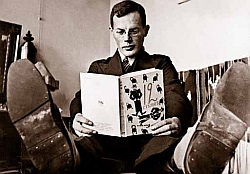 In the summer of 1927 they began writing Dvenadtsat stulyev (The Twelve Chairs).
Valentin Katayev claims that he proposed the treasure hunting motif. Ilf and Petrov were supposed to write a 'raw version', and then Katayev would make a real novel out of it 'with the hand of the master'. It was Ilf who then proposed to really write together, sentence by sentence,
which was how they would continue to write until Одноэтажная Америка
(the American travel book):
every sentence had to be approved by both of them, and when they thought up
the same formulation separately, they would reject it, because that meant it
was too commonplace.
In the summer of 1927 they began writing Dvenadtsat stulyev (The Twelve Chairs).
Valentin Katayev claims that he proposed the treasure hunting motif. Ilf and Petrov were supposed to write a 'raw version', and then Katayev would make a real novel out of it 'with the hand of the master'. It was Ilf who then proposed to really write together, sentence by sentence,
which was how they would continue to write until Одноэтажная Америка
(the American travel book):
every sentence had to be approved by both of them, and when they thought up
the same formulation separately, they would reject it, because that meant it
was too commonplace.
When they showed their first version to Katayev, he was very satisfied and did not think his 'hand of the master' was necessary. It is not certain whether Katayev really played this role in the creation of The Twelve Chairs; his reminiscences are belletristic and notoriously unreliable as to exact facts.
The novel was written very quickly. It appeared in the monthly journal 30
dney from January through July. Valentin Katayev may have helped them
obtain a contract for this important journal so easily - it should be noted that
Ilf and Petrov were not yet great names as separate writers. However, the most
significant person as far as this publication was concerned was Vladimir Narbut,
whom the authors already knew back in Odessa.
He was then editor-in-chief of 30 dney and founder of 'ZiF'
(Zemlya i Fabrika), the publishing company where The Twelve Chairs was published.
Without his prior approval, without a pre-publication contract, it could
never have been published so quickly. And as Odessky and Feldman point out
(in the really excellent foreword in their edition of The Little Golden Calf (4),
where the publication story of the novels is treated extensively),
Valentin Katayev also mentioned a contract in his belletristic reminiscences
Алмазный мой венец. In Мой друг Ильф, a contract is indeed cited,
but the date is given as 21 December 1927 (5). Neither Petrov, nor later
Soviet writers mention Narbut; this was impossible, because he was 'repressed'
and sentenced to death in 1938.
The first book edition appeared in July 1928. The novel met with instant and great
success among readers, both in the Soviet Union and abroad, where translations were soon
published.
The critics were slow to respond. The reviewer of Vechernyaya Moskva
wrote that the novel was funny and light reading, but tiresome. This was the
very first review of Ilf and Petrov's work. G. Blok wrote that it was a mixture
of mockery and jokes, that the social value and literary quality were low. In
1929 other reviews followed. Odessky and Feldman explain the
hesitation of the critics by the political situation of the day, by the position
of Trotzky and his followers in relation to Stalin and Bukharin, and by the fact
that Narbut fell into disgrace.
In 1927, when the novel was written, it served,
politically speaking, as an answer to the left-wing group surrounding Trotzky.
A key element in this respect is the amateurish anti-Soviet conspiracy of
Союз меча и орала
('Union of the Sword and the Plow'), which plays an important role in several
episodes. When the novel appeared, however, Trotzky had already been removed from
the political scene and the critics' attention was drawn more to the sometimes politically
daring satire, which may explain their hesitation to pass a judgment.
More reviews appeared only after Politburo member Nikolai Bukharin had mentioned
the novel during a meeting of
'rabselkors' (a kind of journalist union).
Between the novels
Ilf and Petrov continued writing together and published their novella
Светлая личность (Ogonyok, 1928), and the short story cycles
Необыкновенные истории из жизни города Колоколамска
(Chudak, 1928-1929) and 1001 день, или новая Шахерезада
(Chudak, 1929). By that time, Gudok was no longer the literary
centre for young authors it had been a few years earlier and Ilf and Petrov
stopped publishing in this journal in 1928.
The satirical journal Chudak was set up and headed by Mikhail Koltsov,
who would remain closely connected to Ilf and Petrov in later years also,
during their work for Krokodil and Pravda. Ilf and Petrov wrote
many stories for Chudak.
Chudak sharply criticized Yevgeny Zamyatin and Boris Pilnyak,
who published their work abroad. Ilf and Petrov did not participate in these
or later campaigns against fellow writers. They even wrote a somewhat ambiguous
satirical column (Три с минусом) about the campaign against Pilnyak.
The Little Golden Calf
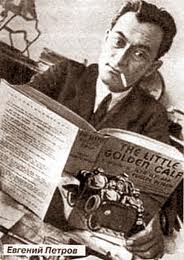 In August 1929 they began writing Zolotoy Telyonok
(The Little Golden Calf), which initially was to be called
Veliki kombinator. Their work on the novel was disrupted,
among other things by Ilf's buying a photo camera and strolling through Moscow
taking pictures. This is how Petrov explains the difficulties in writing
The Little Golden Calf, but the whole truth is somewhat more complicated (4).
In August 1929 they began writing Zolotoy Telyonok
(The Little Golden Calf), which initially was to be called
Veliki kombinator. Their work on the novel was disrupted,
among other things by Ilf's buying a photo camera and strolling through Moscow
taking pictures. This is how Petrov explains the difficulties in writing
The Little Golden Calf, but the whole truth is somewhat more complicated (4).
In April 1930 Ilf and Petrov travelled together with Soviet and foreign journalists
to the opening of the Turksib railway, the railway connecting
Siberia with Central Asia which was to play a central role in the last part of
The Little Golden Calf. They completed the novel in the autumn of
1930 and by November 1930 they had already signed a contract for an English translation.
In 1931 publication in the journal 30 dney began. The publication
was well under way when
they decided to radically change the ending.
Initially they had Ostap marry Zosya Sinitskaya after sending his million to the
minister of Financial Affairs. However, they changed the ending to the more
gloomier version we now know, possibly because of being criticized for creating a
too happy ending, a too positive Bender character.
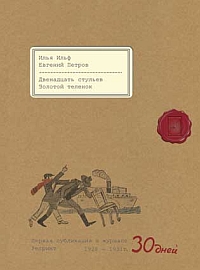
|
30 dney |
The novel was also published in Paris in the Russian journal Satirikon - which had been appearing before the revolution in Russia and was brought back to life by emigrants - and by the end of 1931 in Russian in Berlin. In 1932 translations in German and English appeared.
The delay in publication in the Soviet-Union had to do with the voice of the RAPP. This was a highly ideological organisation of which Ilf and Petrov were of no high opinion, but the dislike was mutual and the liquidation of the RAPP in 1932 was obviously to the advantage of the co-authors.
The reviews were not all good. Some complained about the too positive image of Ostap Bender. The authors in turn complained that Ostap Bender, the Great Schemer, was not understood by the critics.
After the novels
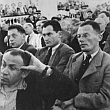 They started thinking about a third novel. It was to be called Подлец
('The Scoundrel'), and there were advertisements for publication in
30 dney. The novel was to be about a man who would have been a
banker if he were an American, but in this novel was to be shown making a
career in the context of the
Soviet-Union. Nothing ever came of
this novel, but in 1935 they treated the theme of 'careerism' in their story
Последняя встреча.
They started thinking about a third novel. It was to be called Подлец
('The Scoundrel'), and there were advertisements for publication in
30 dney. The novel was to be about a man who would have been a
banker if he were an American, but in this novel was to be shown making a
career in the context of the
Soviet-Union. Nothing ever came of
this novel, but in 1935 they treated the theme of 'careerism' in their story
Последняя встреча.
Being already popular with the public, in 1932 they attracted increasing attention
from the critics. They published stories and columns in Krokodil, and,
starting in 1932, also in Pravda, where the Art and Literature department
was headed by their former Gudok colleague A. Erlikh. In 1933 they
published the story collection Как создавался Робинзон.
An important event for Soviet literature was the creation of the Writers'
Union of the USSR in 1934. During the founding congress Mikhail Koltsov recounted
how he had defended Ilf and Petrov against the accusations of the RAPP, but he
also urged them to direct their satire not only to the consumer side of Soviet
society, but to write about 'production' as well.
One of their most remarkable stories after The Little Golden Calf
was Клооп, published in December 1932. It is a satire on bureaucracy,
featuring an organisation where none of the employees, nor the director, know
what it is supposed to do. It got Ilf and Petrov into some trouble with 'the authorities'.
Head of the Pravda in those days was Lev Mekhlis, a former secretary of Stalin.
Ordered by Stalin, Mekhlis asked A. Erlikh about the trustworthiness of Ilf and
Petrov. Erlikh told him that they were loyal writers, but he wrote an article
sharply criticizing this particular story.
In August 1933, Ilf and Petrov travelled with a group of writers to the construction sites
of the White Sea Canal, which was being built by prisoners, both 'political'
prisoners ('kulaks', 'saboteurs') and 'real' criminals. The conditions were
extremely harsh. Many important writers of the day were present: Gorki, Alexey
Tolstoy, Zoschchenko, Valentin Katayev. The result of the trip was a book. Ilf
and Petrov were the only ones to refuse to write a contribution.
In 1933/1934 Pravda presented them with the opportunity to take a trip
abroad. They travelled by boat via Istanbul and Athens to Naples. From there
they travelled to Rome, Venice, Vienna, Paris and back via Warsaw. They had
planned to write a book about the journey, but the fruits, in terms of
publications, remained restricted to two sketches.
Ilf and Petrov also wrote for film and the theatre. The best known of their
works in this respect is Под куполом цирка, written in
cooperation with Valentin Katayev for the music hall, where it enjoyed a great
success in 1934/1935. Later they adapted it, converting it into a film scenario.
The film
Цирк became one of the most popular Soviet films of the Thirties, but
during production the scenario was changed to such an extent that the three
famous writers did not want their names to appear in the credits - they thought
the changes were too extensive, and not to the good.
In 1935 Ilf and Petrov wrote a few columns for the Pravda, such as
Дела студента Сверановского and В защиту прокурора,
which were of a more serious character than anything they had written before.
These columns describe real events in which people were treated badly by the law.
The authors pleaded for justice for the victims.
In the case of the student Sveranovski the
ridiculous sentence of the court (2 years of prison for nothing more than arguing
with a tram conductor) was indeed revoked. Even though it is disturbing
to read about these things against the historical background - the beginning of
a period of unrivalled lawlessness and terror - these columns are very interesting
and well-written and deserve to be better known than they are.
В защиту прокурора again led to a reprimand by Mekhlis.
American road trip
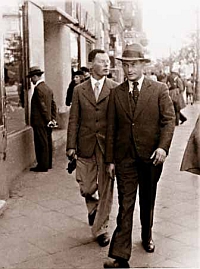 In the winter of 1935/1936 Ilf and Petrov travelled to America: via Le Havre,
then by boat (the famous Normandie) to New York, and then by car to San Francisco,
Los Angeles and back to New York. Their trip would lead to their third and last
major work: Одноэтажная Америка. During their stay, they already published
sketches in the Pravda. The book itself was first published as a serial
in the magazine Ogonyok, under the title of Американские фотографии,
with photographs by Ilf, and later, in 1937, as a separate book.
In the winter of 1935/1936 Ilf and Petrov travelled to America: via Le Havre,
then by boat (the famous Normandie) to New York, and then by car to San Francisco,
Los Angeles and back to New York. Their trip would lead to their third and last
major work: Одноэтажная Америка. During their stay, they already published
sketches in the Pravda. The book itself was first published as a serial
in the magazine Ogonyok, under the title of Американские фотографии,
with photographs by Ilf, and later, in 1937, as a separate book.
During, or possibly prior to the trip, Ilf began to suffer from tuberculosis,
though it was not diagnosed as such at the time. The sometimes dire
circumstances of the trip certainly did not contribute to his health.
Ilf and Petrov were accompanied by an American couple, who are called Mr. and Mrs. Adams
in the book. Mrs. Adams drove the car and Mr. Adams, who had lived and worked in
the Soviet-Union and knew Russian well, was their guide and translator. Ilf and
Petrov themselves knew too little English to undertake the trip on their own.
They met both ordinary and famous people: farmers, workers, native Americans, but
also Ernest Hemingway and Henry Ford. A relatively large part of the book is
devoted to Hollywood, where they held negotiations about a film adaptation of their work
(although nothing came of this) and spoke to many directors, producers and other film people.
After their return they even wrote to Stalin with proposals for reforming Soviet
film production, based on what they had seen in America.
It was a long trip and it was tiring, which is evident from the latter part of
Одноэтажная Америка. There were even plans for a trip to Jamaica, but
itthey did not follow through on these: they wanted to go home.
First they returned to France, where they visited Ilf's older brother Fazini.
He was frightened by Ilf's coughs and tried to persuade him to stay a while, so
that they could consult local
specialists. Ilf would not hear of it and neither would Petrov.
Ilf's illness meant they could not write the whole book together: after their
return, Ilf went to live in a sanatorium outside Moscow. Each of the authors wrote 20
chapters separately, and only 7 chapters were written together. To this day it
is not known who wrote which chapter. The book edition and the authorized English translation
did not appear until after Ilf's
death in 1937.
Both in the United States and in the Soviet Union the book (appearing in two
installments in the journal
Znamya) received mixed reactions.
According to Lidia Yanovskaya (1), the book had a great success among the public,
but there was a negative review in Izvestiya. (The only negative review,
according to Yanovskaya, but she does not quote any positive ones.) V. Prosin,
a young journalist, wrote that the book was too positive about America,
that Ilf and Petrov had failed to denounce the bad treatment of the unemployed
and the negroes.
Besides Одноэтажная Америка, the trip led to a few columns and stories,
and to the novella Тоня, their last jointly written work, which appeared
only after Ilf's death. It was one of their most serious works (and in my humble opinion, not one of their best).
Back in Moscow
Back to 1936. In the spring of this year Ilf and Petrov returned to Moscow.
Ilf wrote in his notebook: "Такой
грозный
ледяной
весенний
вечер, что холодно
и страшно
делается на
душе. Ужасно, как мне не повезло."
Being fatally ill and knowing it, Ilf bore his fate courageously. In his last
year he kept writing in his Notebooks. His last notebook was to be his most
interesting one, not the least because the attentive reader can sense his
pessimism not only about his own fate, but also about that of his country.
Those were maybe the blackest years in the history of Russia. The cultural
climate rapidly worsened, the famous article about Shoshtakovich's opera
A Lady MacBeth from the district
Mtsensk appeared, Pilnyak and Meyerhold, among others, came in for severe
criticism (and were soon to be arrested and sentenced to death). Fear of the
authorities drove many writers and other cultural actors to confirm their
loyalism to the state and sing in the choir of accusations of the so-called
enemies of the people. August 1936 saw the famous trial of Zinovyev and Kamenev
and some other lesser known Old Bolsheviks. A number of writers, Pasternak and
Leonid Leonov amongst them, wrote articles or letters to demand that the
'scum be destroyed'. The same happened in 1937 during the trial of Pyatakov
and Radek. To the honour of Ilf and Petrov they never participated in these
denunciations, at least not while Ilf was still alive.
(By the way, it is not my intention to condemn those who did.) And when Mikhail
Bulgakov was in trouble because his latest play was taken off stage and he was
attacked from all sides, Ilf and Petrov offered him money, knowing that Bulgakov
had already been in financial trouble before this new setback.
Ilf's death
In the spring of 1937 Ilf's health seemed to improve. The authors even started to
seriously consider taking a trip to the Far East. In April they participated in a
meeting of Moscow writers, where Petrov read their article Писатель должен писать.
However, just a few days later, Ilf's health suddenly deteriorated and he died
on 13 April 1937.
His death was a heavy blow for Petrov. His friend had died, and with him the writer 'IlfPetrov'.
Petrov after Ilf
Back to the theme of terror: Ilf died just before the climax of the Great Terror.
After his death many writers fell victim to it. The best known of these was
Isaak Babel, but other victims included Vladimir Narbut and Mikhail Koltsov,
who had played such an important part in the career of Ilf and Petrov. With his
important protectors gone, anything
could now happen to Yevgeni Petrov.
We cannot be sure about Petrov's motives, and they are not ours to judge.
However, his response to the 1938 trial of Bukharin, Rykov, Yagoda and others,
is not the most pleasant moment in this mini-biography. For obvious reasons
Yanovskaya does not mention any of this in her book, and indeed, Lurye's book (2)
is the only place where I have read about this.
Petrov was present at the trial and he wrote about it in the
Literaturnaya gazeta: "…How glad we are that this heavy nightmare
had ended at last, that this most talented, most honest comrade Yezhov, working
night and day, panting in the clouds of poison prepared by the Bukharins and
Yagodas, managed to grab this slimy scum by the throat, to squeeze this vile
throat, to throw this scum on the bench of accused!"
And this about Bukharin, who had helped launch the career of Ilf and Petrov
by bringing The Twelve
Chairs to the attention of the critics, and who is generally seen as one of
the most moderate Politburo and Central Committee members. Yezhov,
on the other hand, is now generally seen as one of the most evil persons that ever
walked the earth.
In 1939 Petrov received the Order of Lenin and became a member of the Communist Party.
Although Ilf's death was very difficult for Petrov, it did not spell the end of
his writing career.
Petrov travelled to the Far
East on his own and he wrote a few sketches and columns about his experiences.
When he returned, he became assistant-editor-in-chief of the Literaturnaya
gazeta, which took up a lot of time and prevented him from writing much.
He also got involved in editorial work for other publications.
In 1938 Ilf and Petrov's Collected Works appeared, in four volumes. Petrov prepared the
publication, but he had to discard some fragments. He did not include the story
Kloop at all, obviously regarding it as too negative.
In 1939 he drew up plan for a book about Ilf. He wrote some reminiscences (part
of which were published as a foreword to a 1939 edition of Ilf's Notebooks), but
the book as a whole remained unwritten. What he wrote about Ilf is interesting,
of course, but at the same time it clearly reflects that it was written in a time
where much could not be told.
Another project of his from this period is something that few commentators mention:
a plan for a futuristic novel, Puteshestvie v stranu kommunizma. The novel was
based on
the fact that the Soviet-Union managed to stay out of the World War II (this was
the year of the Molotov-Ribbentrop pact) and by 1963 had achieved the pinnacle
of communism, a society with no money and no crime. As Kurdyumov/Lurye remarks, this is
one year after, in reality, two men were sentenced to death for illegal money
operations, by a law which was not yet even in force at the moment when the crime
was committed.
It is maybe not such a bad thing that Petrov did not complete
the novel.
In the autumn of 1939 he went as a war correspondent to West-Ukraine. At the end
of the year he also started to collaborate with Georgi Munblit, with whom he wrote
some film scenarios. In 1940 he worked as a journalist at the front of the Finland
war.
In March 1941 he visited the German town of Leipzig as a correspondent for
Izvestii. In June, just before the German attack on the Soviet Union, he
returned to his home country. He started working as a war correspondent and the
pieces which he wrote in this period are a gripping read, even though they are
somewhat conventional.
These war stories were also sent abroad.
Petrov's death
In the summer of 1942 Petrov wanted to go to the Crimea, but he was denied permission
and travelled only to the South-Russian town of Novorossiysk. From there he was
able to travel to Sebastopol on an ammunition ship. On its way back to Novorossiysk,
the ship was heavily bombed and almost sank, but the people on it were saved.
The circumstances of Petrov's death were tragic. According to many internet sources
the airplane from Novorossiysk to Moscow was shot down by German planes,
but in fact it crashed, flying low to avoid being taken for a German plane by the
anti-aircraft defense. According to Admiral Isakov, as quoted by Lurye, the pilot
had scared some cows with its shadow as a joke to divert the passengers and had
become careless in the process. However, according to the
website
of the
Odessa Literature Museum, this is a myth. Yevgeny Petrov was the only passenger not to survive the
crash, as Mrs. Alexandra Ilf, Ilya's daughter, told me.
Posthumous publication and criticism
In 1949 the authorities reproved the publishing company Sovyetski Pisatel for
publishing a new edition of The Twelve Chairs and
The Little Golden Calf.
This was called a 'crude mistake' in a resolution of the Writers' Union by A.A. Fadeyev.
Critics started to write negatively about Ilf and Petrov's works. Their work was
not available
in the Soviet-Union until 1956 with the dawn of the 'Thaw' after Khrushchov
came to power, and in 1961 the second edition of Collected Works was
published. From that time onwards, their work has remained popular in the Soviet-Union
and Russia and Ilf and Petrov have retained their place in the canon of Russian literature.
New editions of their work keep appearing.
By the end of the 1950's, Ilf and Petrov's work began to be seen by some as 'anti-Soviet'.
However, both Nadezhda Mandelstam (in the first volume of her memoirs, New York, 1970)
and the well-known dissident-writer Arkady Belinkov (in his book Sdacha i gibel sovetskogo intelligenta. Yuri Olesha, Madrid 1976) accused them of ridiculing the intelligentsia. On the other hand, Vladimir Nabokov, who detested Soviet literature in general, made an exception for Olysesha, Zoshchenko and Ilf and Petrov.
Family
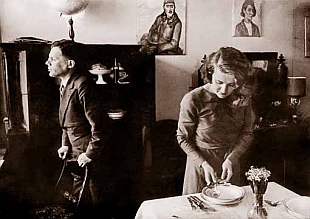 |
Ilf with his wife Maria Tarasenko | |
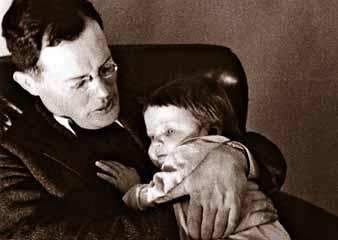 |
Ilf with his daughter Alexandra | |
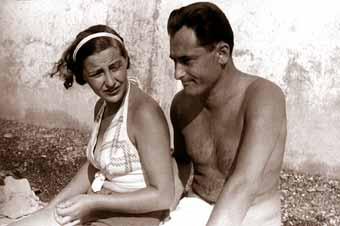 |
Petrov with his wife Valentina Gryunzayd | |
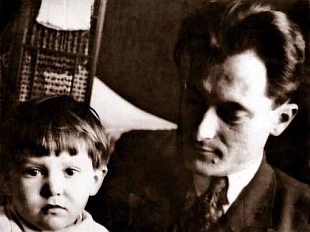 |
Petrov with his son Pyotr | |
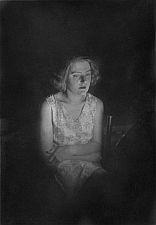 |
 |
There seems to be a certain similarity between the two beautiful wives of Ilf and Petrov... |
In 1929 Yevgeny Petrov married Valentina Gryunzaid, to whom Yuri Olesha had dedicated his famous fairy tale Tri tolstyaka ('Three Fat Men'). They had two sons: Pyotr, who was a well-known camera operator and Ilya, who was a composer before he sadly passed away in 2009.
The personalities of Ilf and Petrov
Ilf and Petrov were a successful writer's duo, but that does not mean that their
characters were alike. A consistent picture arises from all the reminiscences:
Ilf was rather shy and reticent, and although he was basically a kind person,
he could be very
sharp, even merciless, towards people he did not respect. Petrov was easy-going,
optimistic and he smiled and laughed a lot.
He played the piano well. Petrov took care of
business affairs and was the one that spoke for both writers on public occasions.
According to all testimonies, both Ilf and Petrov were principled, morally strong
people, who demanded the same strength of character of their fellow men.
I would like to end this biographical sketch with a quotation from the Memoirs
of Ilya Ehrenburg, which I find rather touching:
В
литературной
среде Ильф и
Петров
выделялись:
были они
хорошими
людьми, не
заносились,
не играли в
классиков, не
старались
пробить себе
дорогу
правдами и
неправдами.
Они брались
за любую работу,
даже самую
черную, много
сил положили
на газетные
фельетоны;
это их
красит: им хотелось
побороть
равнодушье,
грубость, чванство.
Хорошие люди
- лучше не
скажешь. Хорошие
писатели, - в
очень
трудное
время люди
улыбались,
читая их
книги. Милый
плут Остап
Бендер
веселил, да и
продолжает
веселить
миллионы
читателей. А
я, не будучи
избалован
дружбой моих
товарищей по
ремеслу, добавлю
об Илье
Арнольдовиче
и Евгении
Петровиче -
хорошие были
друзья.
References
The main references for this article are the following books (by way of
exception I use the scientific transliteration):
(1) L.M. Janovskaja, Počemu vy pišete smešno? - Nauka,
Moscow 1969
(2) A.A. Kurdjumov [Ja.S. Lurje], V kraju nepugannyh idiotov - Paris, La
Presse Libre, 1983
(3) I. Il'f and Je. Petrov, Dvenadtsat' Stuljev, M. Odessky and D. Fel'dman
(eds.) - Vagrius, Moscow 1997/2000
(4) I. Il'f and Je. Petrov, Zolotoj telënok, M. Odessky and D. Fel'dman
(eds.) - Vagrius, Moscow 2000
(5) Je. Petrov, Moj drug Il'f, Aleksandra Il'f (ed.) - Tekst, Moscow 2001
(6) G. Munblit and A. Raskin (eds.), Sbornik vospominanij ob I. Il'fe i Je.
Petrove - Sovetskij pisatel', Moscow 1963
See for more books the bibliographical page.

Document history of this page:
First online - 18/11/2010
Last minor corrections - 20/12/2010
Last major corrections -
I thank Maggie Westera-Bailey for brushing op my English in the first online version of this text. However, any mistakes are entirely my own responsibility.